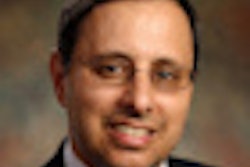Many radiologists feel that speech recognition dictation systems -- one of the cornerstones of digital efficiency -- were thrust upon them. While the systems had the potential to dramatically reduce radiology report turnaround time and operating costs, their use has been burdensome to many radiologists by decreasing their productivity.
An article published online October 10 in the Journal of Digital Imaging suggests that speech recognition technology could benefit radiologists, their practices, and their departments by identifying occupational stress and fatigue. Dr. Bruce Reiner, director of radiology research at the Baltimore Veterans Affairs Medical Center, believes that this oft-maligned technology could be modified to incorporate "early warning systems" individualized to the dictating radiologist.
If such warnings are heeded, speech recognition systems could help reduce errors made in interpreting studies and/or dictating reports.
Detecting voice stress
Voice stress analyzers (VSAs) have been in use for years to detect stress in the acoustic properties of speech, including intensity, spectral structure, pitch distribution, glottal source factors, and duration. Layered voice analyzers (LVAs) use a wider spectrum of criteria and can evaluate a wider range of emotions, including confusion. They are being used in standard computer software, handheld devices, and server-based intelligence systems.
"The radiology profession can be stressful with multitasking responsibilities and high workload stress," Reiner said. "Some intrinsic stressors are predictable and 'routine,' such as increasing task complexity and high workload cycles. A personalized speech stress profile would take these into account and correlate them with the historical performance and stress measures of an individual end user."
Just as speech recognition systems are taught to improve their performance with an individual user, Reiner envisions a smart VSA/LVA that would adapt and be cognizant of routine stress experienced by a radiologist. A personal speech profile would provide a method for dynamic user identification and authentication. It would measure the stress recorded during the authentication process, and cross-reference this with the user's speech stress profile database to gauge how the "check-in" stress level related to the historical measures of the end user and his/her performance outcomes.
If a user had a stress rating considered unacceptable based on prior performance and errors, the user could be directly alerted or even locked out of the system. Acceptable stress, however, not only needs to be individualized, it also needs to be dynamic and offer some degree of flexibility, Reiner noted.
If such a system were implemented, a radiology department or practice could develop a standardized stress database that could be correlated with workflow and outcomes data, Reiner suggested. It could become a technology assessment tool, providing a standardized mechanism for correlating stress/fatigue measures with workflow, task complexity, and clinical outcomes. It also could be used to create customizable stress interventions commensurate with individual end-user preferences, profile characteristics, and performance.
While Reiner is a proponent of speech recognition systems with integrated VSA/LVA capabilities, he also recognizes the problems they could generate.
"This technology could have an adverse effect on radiologist productivity and departmental workflow," he said. "Workflow changes could be made, or some studies could be outsourced to a teleradiology service provider."
"The ultimate goal is to continuously refine the personalized speech profile in accordance with the dynamic and changing attributes of each individual end user," according to Reiner. "Historical stress and performance data would be used to predict future stress and guide ‘best use' applications of the technology, as it relates to the specific task and end user."
Smaller practices might find a stress profile tool to be disruptive and impractical. It also could potentially be used in medicolegal matters, he added. The unanswered question is whether it could improve quality and patient safety in a radiology department without contributing to worry and stress while doing so.
When AuntMinnie.com asked Reiner if such a system was being used experimentally, either at his hospital or deployed by a speech recognition systems vendor, his answer to both questions was "no."



















